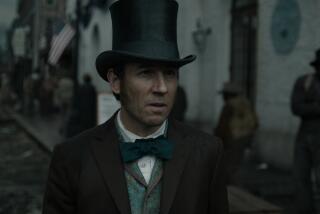‘U.S. Marshals’ Hot on the Trail of . . . ‘The Fugitive’
Warner Bros., which probably knows what it feels like to be persecuted and unloved (especially after a year like last year), has put its waning hopes and diminished expectations behind traditional values--one, at any rate: When in doubt, find an idea that has already worked and beat it to death. Then, blow it up.
The idea is “The Fugitive,” itself a remake of a TV show, but one that Andrew Davis’ direction, Harrison Ford’s stolid dignity and Tommy Lee Jones’ gruff charm made into a first-rate entertainment. Jones won an Oscar, and it was a popular choice. So popular that he now has his own movie, “U.S. Marshals,” in which every subtle aspect of the original has been taken to its seemingly inevitable extreme.
It starts typically/topically enough, with a truck-car wreck in Chicago caused by a cigar-chomping exec talking on his car phone (that he’s not a soccer mom can no doubt be credited to the studio’s market-research department). The truck driver with the bad luck is Mark Sheridan (Wesley Snipes), who’s wanted on a federal arrest warrant for killing several federal agents back in New York. The U.S. marshal leading the pursuit after Sheridan becomes--gasp!--a fugitive, is Sam Gerard (Jones).
The initial escape is like something out of “Con Air”--and “Turbulence” and “Die Hard 2” and “Air Force One” and maybe even “Airplane!”: a jumbo jet full of convicts crash-landing, sliding down a hillside into a lake, flipping over and sinking. All prisoners accounted for, sir, except the ruthless, cruel, heartless assassin Mark Sheridan.
But, of course, he’s not ruthless and cruel. He’s a really nice guy, says his girlfriend (Irene Jacob, in a truly awful performance), and Gerard himself can’t quite figure out why, if Sheridan is so ruthless, he hasn’t killed any of the Jerry Springer refugees he’s taken hostage on his very successful flight to freedom.
Along with those doubts, Gerard has been given “help” in the person of State Department agent John Royce (Robert Downey Jr., who you’d think had enough problems). Gerard doesn’t like him, but Royce does provide a foil (“Get yourself a Glock and get rid of that nickel-plated sissy pistol,” Gerard says, demeaning both his artillery and his manhood). And he provides a distraction from the precious interplay of Gerard’s regular team of deputies, all “Fugitive” veterans, including Joe Pantoliano, who seems to be morphing into Garry Marshall.
As the chase goes on--and on--the most irritating thing about “U.S. Marshals” is the sense that it’s a movie-by-committee, that every line and every aerial shot is calculated to seduce, through a sense of either deja vu or how much money is being lavished on screen. So, ultimately, it’s a trade-off. Go see it. But you’ll feel cheap in the morning.
* MPAA guideline: PG-13 for some scenes of violence and brief language. Times guidelines: heavier than the average TV movie, with adult situations.
‘U.S. Marshals’
Tommy Lee Jones: Chief Deputy Marshal Samuel Gerard
Wesley Snipes:Sheridan
Robert Downey Jr.:John Royce
Lorenzo Clemons: Stark
Irene Jacob: Marie
Joe Pantoliano: Deputy Marshal Cosmo Renfro
LaTanya Richardson: Cooper
Ray Toler: Earl
Kate Nelligan: U.S. Marshal Walsh
A Warner Bros. production. Directed by Stuart Baird. Written by John Pogue. Cinematography Andrzej Bartkowiak. Music Jerry Goldsmith. Production design Maher Ahmad. Costume design Louise Frogley. Editing Terry Rawlings. Executive producers Keith Barish and Roy Huggins, Wolfgang Glattes (co-executive producer). Producers Anne Kopelson, Arnold Kopelson, Stephen Brown (co-producer). Running time: 2 hours, 8 minutes.
*
* In general release throughout Southern California.
More to Read
Only good movies
Get the Indie Focus newsletter, Mark Olsen's weekly guide to the world of cinema.
You may occasionally receive promotional content from the Los Angeles Times.










